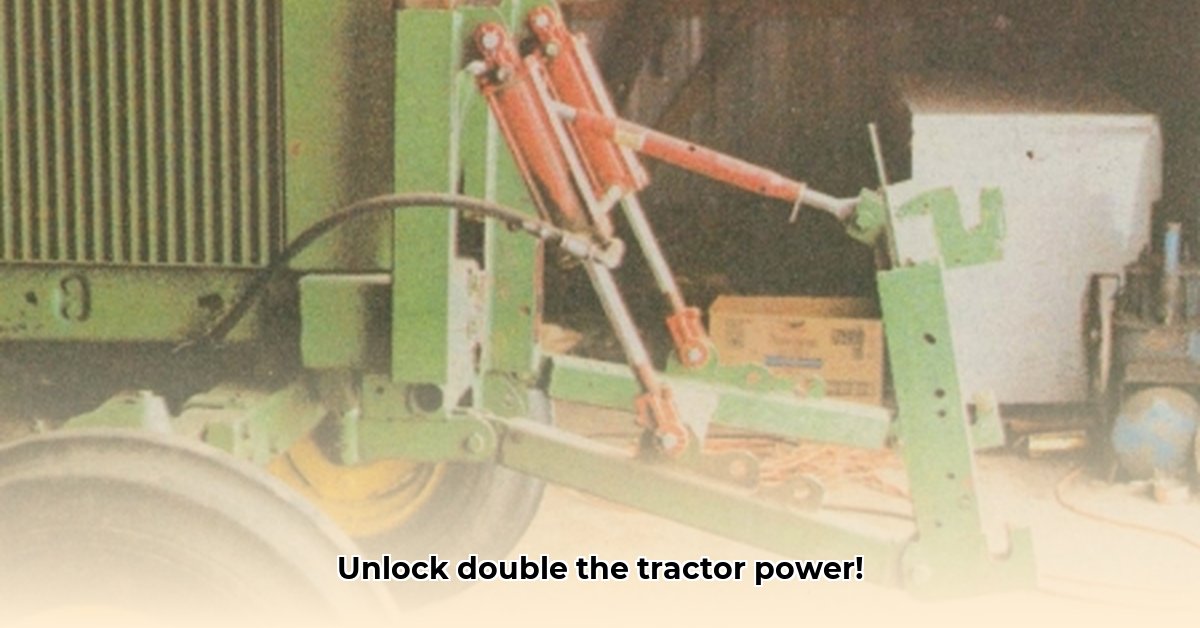
3-Point Hitch for Front of Tractor: Double Your Tractor's Power, Boost Your Farm's Sustainability
Looking to significantly enhance your tractor's capabilities and embrace more environmentally friendly farming practices? A front-mounted 3-point hitch offers a compelling solution. This innovative system allows your tractor to perform two tasks concurrently, dramatically increasing efficiency and promoting sustainable agriculture. Let's explore its mechanics, benefits, and implementation. For more detailed information on 3-point hitches, check out this helpful resource.
Doing Two Things at Once: The Efficiency Edge
The core advantage of a front-mounted 3-point hitch lies in its ability to equip your tractor with implements on both the front and rear, enabling simultaneous operations. Imagine planting seeds while simultaneously fertilizing, or cultivating and spraying in a single pass. This doubles your operational efficiency. This translates to considerable savings: reduced fuel consumption, minimized equipment wear, lower labor costs, and ultimately, improved profitability. Isn't that a compelling reason to consider this technology?
Protecting Your Soil: A Foundation for Sustainable Farming
Repeated passes with heavy machinery compact soil, negatively affecting water absorption, root growth, and overall yields. The reduced number of trips across your fields when using a front-mounted hitch significantly lessens soil compaction. This leads to healthier soil, a cornerstone of sustainable farming. Maintaining healthy soil directly translates to higher crop yields and a decreased reliance on chemical fertilizers and pesticides—a significant environmental benefit.
Beyond Fuel Savings: Environmental Advantages Abound
Minimized field passes achieved with dual implements mean reduced fuel use and therefore reduced greenhouse gas emissions. The positive effects on soil health further reduce the need for chemical inputs, lessening your farm's overall environmental impact. It's a win-win scenario—boosting your profits while minimizing your environmental footprint. How much fuel do you think you could save?
The Investment: A Smart, Long-Term Move?
The initial cost of a front-mounted 3-point hitch system is substantial. However, many farmers find the long-term returns easily offset this initial investment. Savings in fuel, labor, and reduced environmental impact frequently outweigh the upfront costs. Nevertheless, a thorough cost-benefit analysis, considering your operation's size and workload, is recommended. Exploring leasing options or investigating government subsidies can also ease the financial burden.
Taking the Leap: A Step-by-Step Guide to Implementation
Successfully integrating a front-mounted 3-point hitch requires careful planning and execution. Follow these steps for a smooth transition:
Assess Your Needs: Identify tasks suitable for simultaneous operation and the necessary implements. This will guide you toward the appropriate system for your farm.
Research Compatible Systems: Explore various brands and models, ensuring compatibility with your existing tractor and implements. Thorough research is key to making an informed decision.
Invest in Training: Proper training on safe and efficient operation is crucial. Your equipment dealer should offer training or direct you to reliable resources. Safety should always be the top priority.
Start Small – Pilot Program It: Begin with a trial run on a smaller section of your land to refine techniques and identify potential issues before full-scale implementation. A methodical approach is essential.
Analyze and Refine: Monitor fuel consumption, time savings, soil health, and yields. This data will allow for informed adjustments and optimization of your approach.
Addressing Potential Concerns: Minimizing Risks
| Potential Challenge | Mitigation Strategies |
|---|---|
| High Initial Investment Cost | Explore financing, leasing, or government subsidies. |
| Operator Training and Skill | Invest in comprehensive training and practice. |
| Compatibility Issues | Verify compatibility before purchase. |
| Maintenance and Repair Costs | Choose a reputable supplier with strong warranty coverage and readily available parts. |
| Potential Mechanical Failures | Implement a regular maintenance schedule. |
A Sustainable Future, One Field at a Time
Adopting a front-mounted 3-point hitch represents a significant step towards sustainable farming. It's an investment in your farm's long-term health, profitability, and environmental responsibility. Are you ready to transform your farming practices for a brighter future?
Double Your Tractor's Power: Quantifying Fuel Savings and Soil Compaction Reduction with Front-Mounted Hitches
Key Takeaways:
- Front-mounted hitches significantly improve efficiency by enabling simultaneous operations.
- This efficiency translates to noteworthy fuel savings and reduced soil compaction.
- Rigorous data collection and analysis are vital to accurately quantify these benefits.
- A comprehensive cost-benefit analysis is crucial to assess economic viability.
- Long-term environmental impacts require further investigation and research.
Quantifying the Benefits: A Practical Approach
To move beyond anecdotal evidence, let's outline a method for quantifying the benefits of a front-mounted three-point hitch:
Step 1: Controlled Field Trials: Conduct trials comparing single-pass and dual-pass operations on identical fields. Precise fuel consumption measurement using calibrated equipment is critical.
Step 2: Accurate Soil Compaction Measurement: Use penetrometers to assess soil compaction levels before and after operations, comparing areas worked with and without the front-mounted system.
Step 3: Data Analysis and Interpretation: Compare fuel consumption and soil compaction data to determine the percentage reduction achieved by employing the front-mounted system.
Step 4: Cost-Benefit Analysis: Compare the initial investment with the calculated savings in fuel, labor, and potential yield increases to determine the return on investment (ROI).
Step 5: Long-Term Sustainability Assessment: Monitor long-term effects on soil health, crop yields, and environmental impact through multi-year data collection and observation. This is crucial for understanding the complete picture.
Operational Considerations and Challenges
The effectiveness of a front-mounted hitch depends on factors like terrain, crop type, and implement selection. Proper operator training is essential for safe and efficient operation. While the initial investment is substantial, the long-term benefits should be carefully considered.